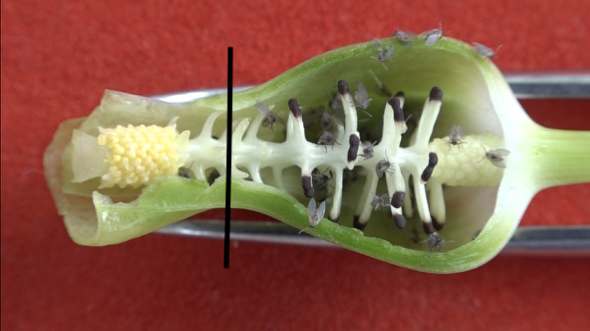Part 1: HERE; 2 HERE and 3 HERE.
The insects responsible for pollination of Rodent Tuber (Typhonium flagelliforme) are gnats, specifically Moth Flies (Diptera: Psychodidae) LINK and LINK.
Video surveillance documented these flies entering and exiting the base of the inflorescence from the narrow space between the spadix and the spike which acts as a trap LINK. The flies were attracted to the trap by a powerful scent released by the spadix. Only after the flies had pollinated the female flowers at the base of the trap will the exit widened somewhat (or is it the wall of the trap becoming less slippery?) to make escape possible. By this time the male flowers around the passage would have released their pollen, thus dusting the flies as they crawl out of the trap. Once out, these flies will fly to another inflorescence and transfer the pollen on their bodies to the female flowers.
![Typhonium divaricatum fl Araceae [wyc] - 1 (1)](https://besgroup.org/wp-content/uploads/Typhonium-divaricatum-fl-Araceae-wyc-1-1.jpg)
In an effort to show exactly how these flies move out of the trap, the inflorescence is cut just above the neck of the trap. The above image shows exactly where the cut is made… at A-B. The image below of a longisection of the trap also shows the point of cut – black line.

Note the many Moth Flies inside the trap. The female flowers are clumped towards the right, at the base of the trap, appearing whitish. The male flowers are at the extreme left, just beyond the black line. The many bare branches between the male and female flowers are sterile flowers that probably control the movement of the flies in and out of the trap. Below image shows the opening after the cut and a few flies that had escaped.

The first part of the video clip below shows the flies moving between the sterile projections (sterile flowers) to escape from the trap. The second part shows ants that invaded the trap for the nectar, escaping from the left as the folds of the spathe had widened due to the cutting of the upper portion. The white piece on the left is a bit of tape that was supposedly to prevent escape of the ants. It should be noted that two inflorescences were involved in the video as once ants invaded the trap, they dominate inside. So, there are either flies or ants inside the trap. Whether the ants are involved in pollination needs to be looked into.
YC Wee
Singapore
15th December 2017








